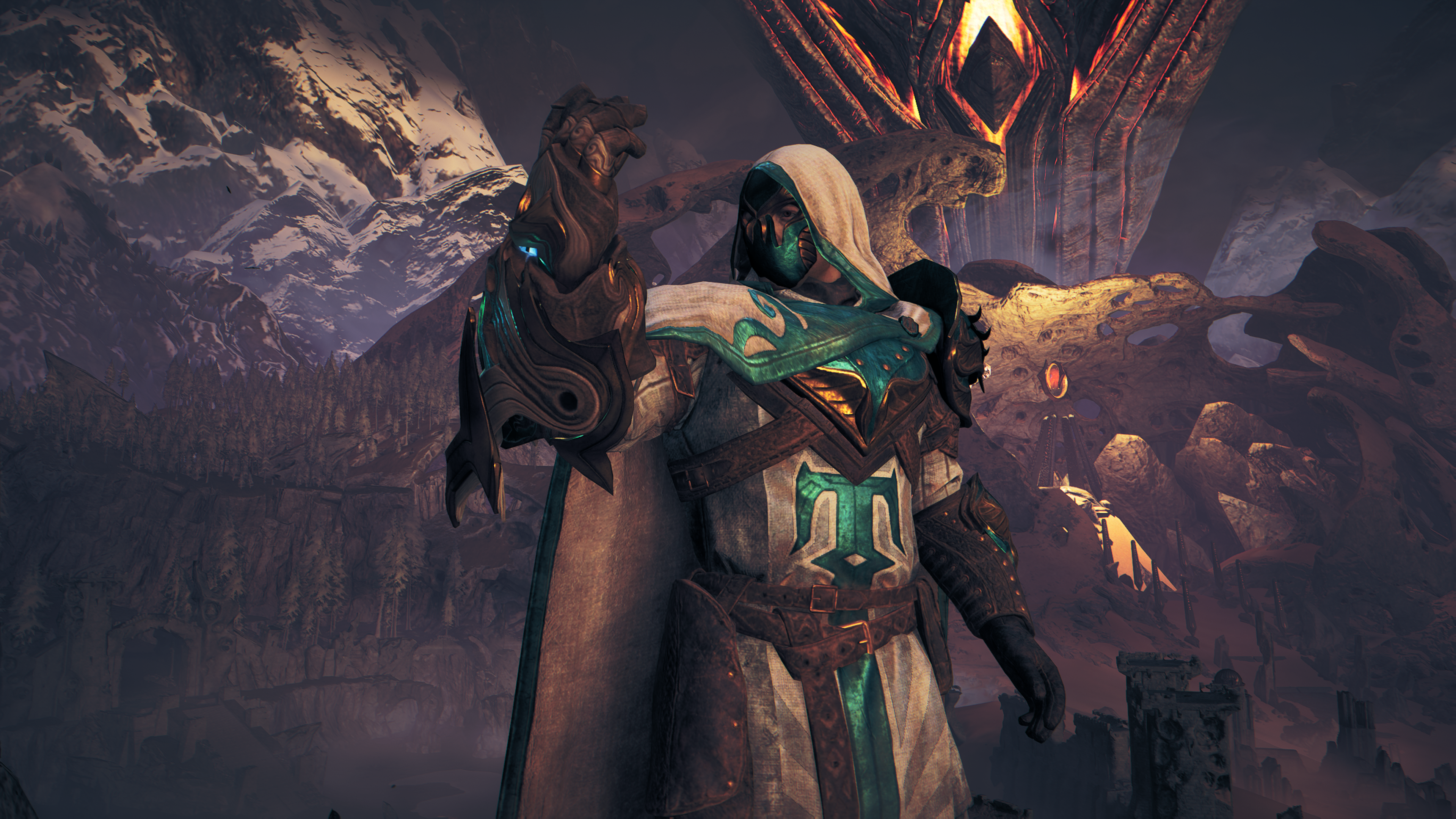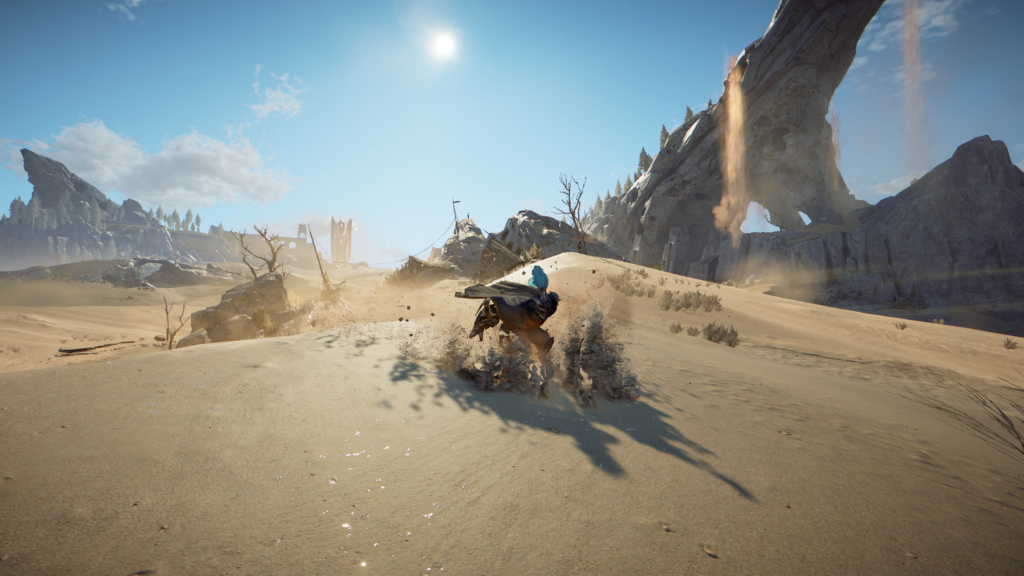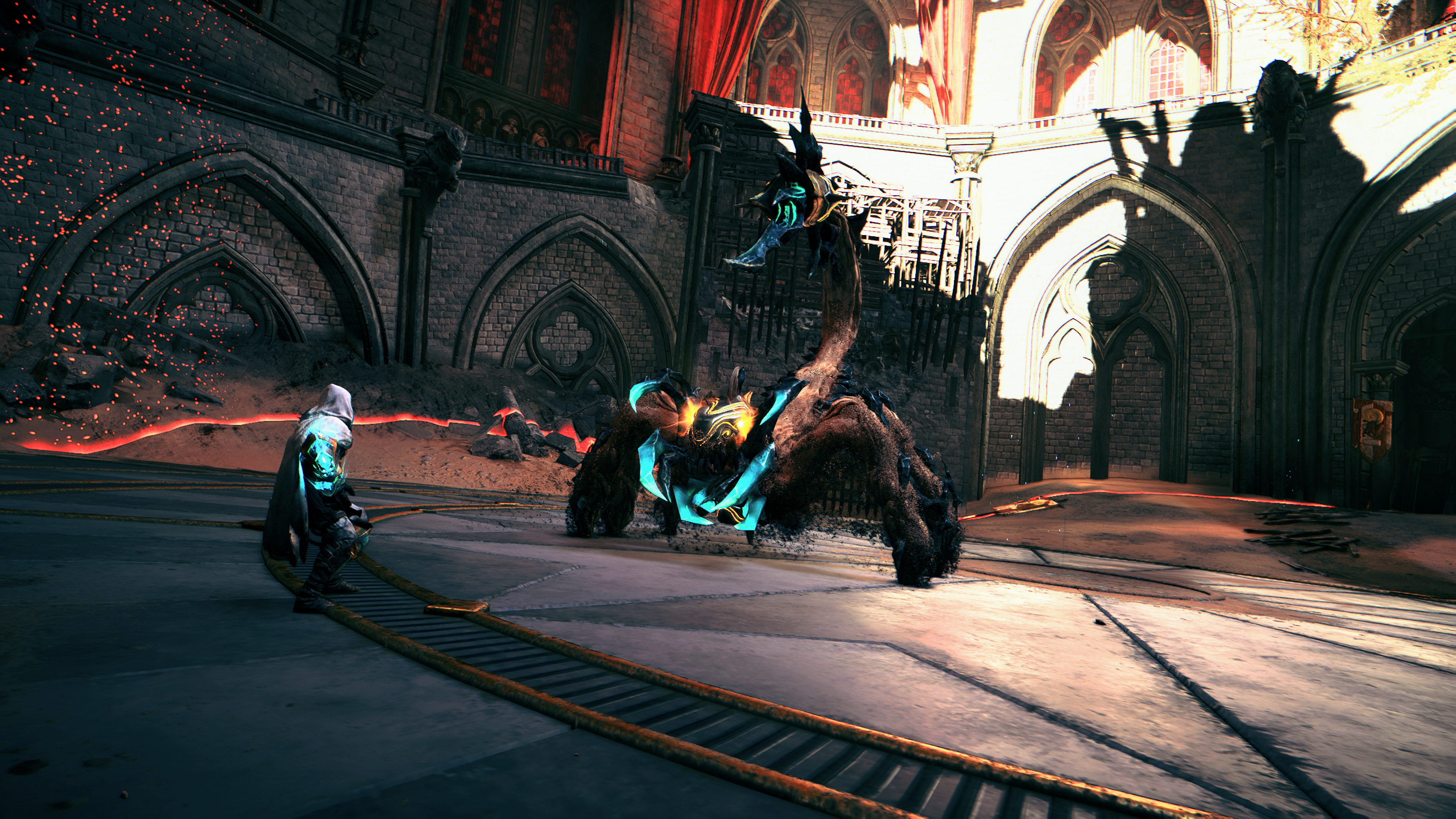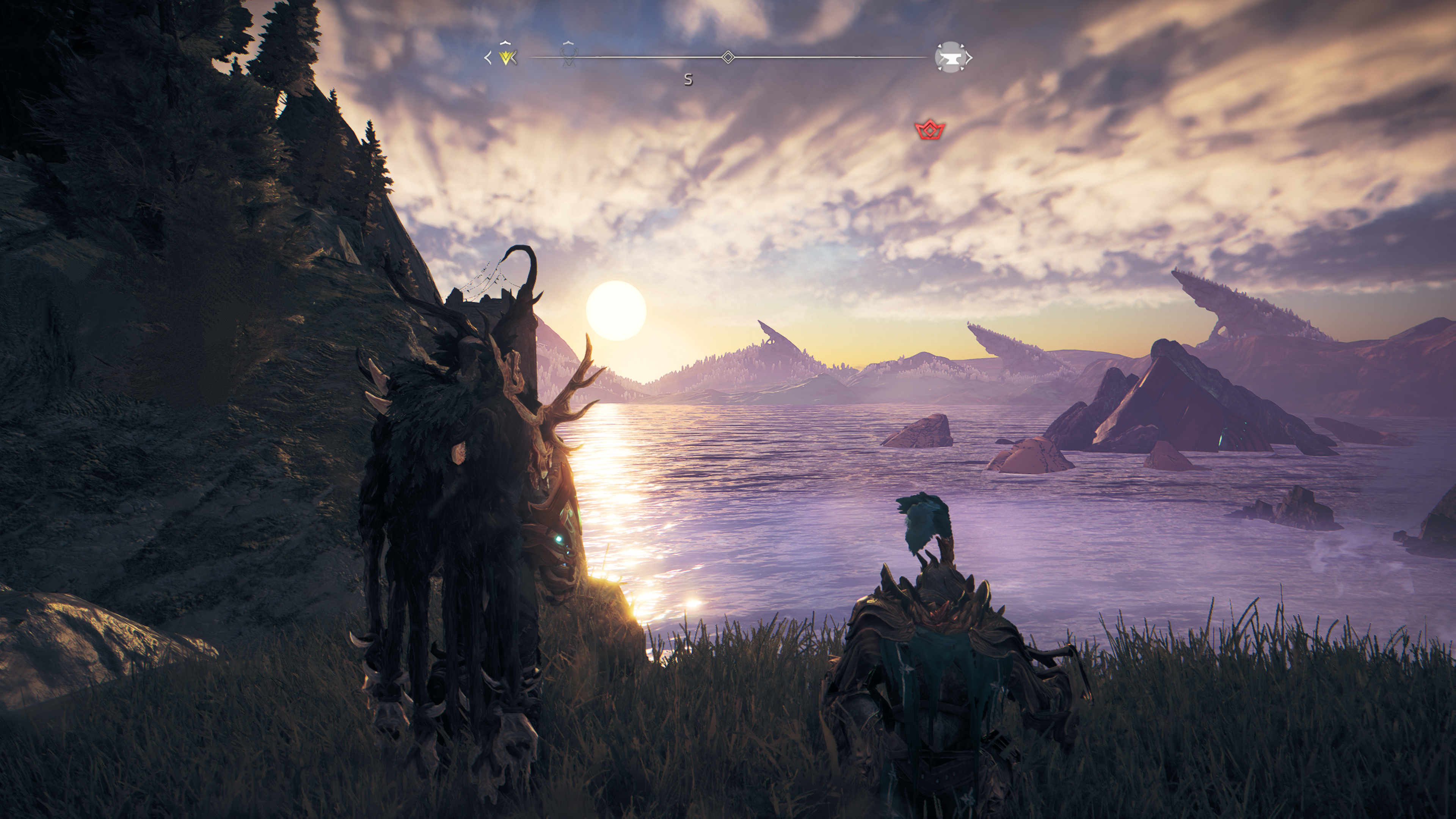I am more than happy to welcome a brand new third-person, action-adventure RPG into my library, and have been looking for a new one to play on Xbox for some time now. Thankfully, Focus Entertainment may be coming to the rescue with their latest game, Atlas Fallen. The game promises players the ability to hunt down monstrous sand creatures, all while utilising a variety of different playstyles. This all culminates in a rebellious story as the player will venture to bring salvation to humanity by putting an end to the rule of an oppressive god, known as Thelos.
If you’re a fan of games like Assassin’s Creed, Monster Hunter or previous releases from Focus Entertainment, like Evil West, then Altas Fallen is a game you might be interested in. While not carbon copies of the games mentioned, Atlas Fallen combines a number of elements that can be traced back to each of them; from a full co-op story experience, similar to fighting side by side against the horrors of the world in Evil West, to the barren sands and exploration, comparable to Assassin’s Creed Origins and the giant beasts you must tactically slay in Monster Hunter, Atlas Fallen has it all. Don’t worry if the games mentioned above don’t tickle your fancy, however, as Atlas Fallen is unique in its own right.
Starting up the game, you begin the prologue as a character who we come to know as Nyaal. You begin in an unforgiving prison world, facing monsters and traversing a 3D platform-style environment. It is here where the game teaches you the core mechanics such as movement, platforming and combat. The gameplay is fast-paced, smooth and with refined combat and movement, you feel like a force to be reckoned with.
Once through the relatively short introduction, your next step is one of my favourite steps in RPG games: creating your character. However, the character creator feels fairly limited for options of customisation but due to the nature of the game having outfits that will likely cover any custom adjustments you have made, this really doesn’t present itself as much of an issue. There is an option to always have your character look as you designed it or to remove the helmet on your armour to see the beautiful face you have designed but personally, I want my badass helmet.

Now that you have your desired custom look, you set off on your narrative adventure. You find yourself at a camp, known as an “unnamed”. A human granted no title and enslaved by those who believe to be chosen by Thelos (The Sun God). You and your fellow unnamed make a stand in protest against your oppressors. Your protest causes you to be sent out into the desert to fend for yourself against fearsome sand monsters known as wraiths and find a stolen belonging for the camp leader in order to gain their favour. This leads you to a gauntlet, a powerful artefact that is used to control the sands. The Gauntlet will allow you to form weapons, and learn new skills and abilities that will allow you to survive on your journey. Alongside this, Nyaal’s spirit is found to be imbued in the gauntlet and will guide you on your quest throughout your journey.
Atlas Fallen has a main story, bolstered by side quests and other smaller tasks that can be completed in the world as you explore. You will meet other main NPC’s but there are also a number of minor characters to meet on your travels that will give you different quests and challenges to face on your journey. The story’s presentation can feel a bit generic at times and I often found myself wanting to skip dialogue to get back to the action. The generic nature of the game’s narrative is what I would consider the weakest part of the game, with additional issues when you are playing co-op. When in co-op, you or your player 2 can begin conversing with NPC’s but if you are not directly next to your fellow player then you can miss vital information so communication with your player 2 is needed. It would have been an improvement to have forced the other player to be within range of the dialogue to ensure no information was lost between parties, similar to how this is done in the co-op experience of a game like Dead Island 2.
While I admit the narrative is the weakest part of Atlas Fallen, it does not mean it is inherently bad. However, when comparing the experience to the rest of the gameplay it is often more of a formality to complete to get back to the more appealing gameplay.

The Gauntlet is your source of power. Not the power you’d use to click your fingers and dust half of the universe’s population, but instead the power to control dust. Okay, it isn’t to control dust, but you are given the power to control sand. This opens the game up to some really interesting and well-thought-out mechanics. You will start off the game with one weapon, the DuneCleaver but soon after you’ll unlock the Sand Whip. Overall, there are three weapons to acquire throughout your journey. Each weapon comes with unique attacks that can be implemented into your own unique playstyle.
So you may be asking, “So what else can this gauntlet do?” Well, you can cut the sass because I am about to tell you. It can raise giant structures from the ground, that’s pretty cool, right? By creating access to new areas with the power of sand you can unearth chests to find new loot, solve puzzles in the open world and embody yourself in sand to parry. Alongside this, you can double jump and air dash across massive valleys to get to hard-to-reach areas. But the pièce de résistance is the sand sliding. Sand Sliding is the ability to, well, slide on the sand and it is awesome! It’s a bit like playing Steep or Riders Republic when you are skiing or snowboarding through a vast landscape, except in Atlas Fallen there is no board or skis, you majestically glide across the dunes by propelling the sand beneath your feet. This mechanic makes traversing the open plains a dream as it is much faster to get between point A and point B. This can make the exploration for impatient people like myself much more enjoyable. In most games, I probably overuse the fast travel feature but in Atlas Fallen, I rarely bothered as the trip is quick and fun to make.

I have already spoken about the movement utilised by the Gauntlet and how it helps you traverse the world, but I wanted to add weight to the joy that it is to move in this game. The exploration feels diverse and traversing outside of the main quests to look for collectables feels worthwhile and rewarding. In the explorable areas there is a sense of openness making the world feel more interesting and with large structures to climb and puzzles to get to new heights you may find yourself questioning what is atop some of the highest points.
While we are on the topic of the things Atlas Fallen does well, let’s talk about combat. Firstly, combat is smooth, accurate and overall refined. Unlike games like Monster Hunter where you may struggle to keep your enemy in your metaphorical crosshairs, you will feel comfortable locking onto a target and striking it with accuracy. On a negative note, health management can be frustrating at times due to it being unclear when your health is low. Although the health bar is on screen at all times, you are not always paying attention to it during a fight and this can cause an early demise. It would have been good to have had a stereotypical red around the edge of the screen, or other clear indicator to know you are on low health. I believe there is a slight audio queue, however when in the middle of a fight these audio queues can sound similar to those activated when using an ability.

As the game progresses your combat experience grows with the use of the perk and skill tree system. The skill tree offers customisable abilities that you can find and craft using the materials you acquire around the world, these are called Essence Stones. Once equipped, Essence Stones are activated through a system called Momentum. Momentum is gained every time you hit an enemy, and lost from either using up that power on abilities or from being out of combat for an amount of time. As you gain Momentum, a bar fills up at the lower corner of the screen, showing which of your Essence Stones are active. The abilities from these vary from the stones you choose to put on which adds a tactical and interactive edge to the skill tree-like system. Given Atlas Fallen sells itself on making a custom playstyle for your character, in my experience, they have been successful in delivering on this.
However, player customisation is not only restricted to the skill tree and abilities as cosmetic upgrades are also available. Throughout your journey, you will gain access to new armour sets, which will offer buffs to your character’s defence, attack and more. You will also find items to customise your armour’s colour, add attachments to it and even make your armour with the best stats look like your armour that is the most aesthetically pleasing.

I previously mentioned the co-op gameplay but what I haven’t mentioned is how impressed I am with it. Co-op is smooth, responsive and adds a revive mechanic meaning it can be easier to take on large boss fights and progress through the game. There is no tether in co-op play which is a win for those who play with a second player who likes to wander. The co-op also has a nice feature where if you join someone who is further into the game than you, you will still gain their weapons and gauntlet upgrades, allowing you to be a useful ally regardless of your progress or experience in your own playthrough. Progress made in a host’s game can also be saved by the joining player so they can keep the progress made in their own individual save file. This is an optional but useful feature that is often overlooked in other co-op experiences like Far Cry, where it can be frustrating to have gained very little from helping a friend in their world. This also allows you and your co-op partner to play the entirety of the game together. So far, the only losses I have noticed from co-op gameplay are Photo Mode and my previously mentioned dialogue issues where your player 2 can pick up quests without your knowledge.

Overall, Atlas Fallen is a fine addition to my RPG collection. It delivers an interesting world to explore with new discoveries to be made around every dune. The combat and mechanics add a custom experience that feels fresh, yet familiar enough that the learning curve isn’t too steep. Co-op is seamless and offers an extra element to the experience where your co-op partner will feel part of their own independent story, rather than the person being handed the dodgy 3rd party controller. Graphically, Atlas Fallen looks good, it is not a spectacular-looking game but this isn’t something that I ever took issue with. One key point I want to highlight is the lack of performance issues for a new game, which in my experience is quite rare in this generation. I have had one crash in my journey of 22 hours and I am certain this was due to factors external to the game. Atlas Fallen delivers in all areas, regardless of a fairly generic storyline. Like in most RPG games, there are a few grindy quests and fetch quests but I was never overwhelmed by these and they are very much optional. Upon finishing the campaign I felt accomplished, and hopeful that we might see a sequel t Atlas Fallen in the future.
Overall
-
CX Score - 80%80%
Summary
Pros:
- Gauntlet Mechanics are fantastic
- Co-op experience is well delivered
- Variety of customisable combat options
- 22+ hours to complete all quests on Normal Difficulty
Cons:
- Story can feel generic at times
- Low health indication is unclear at times
